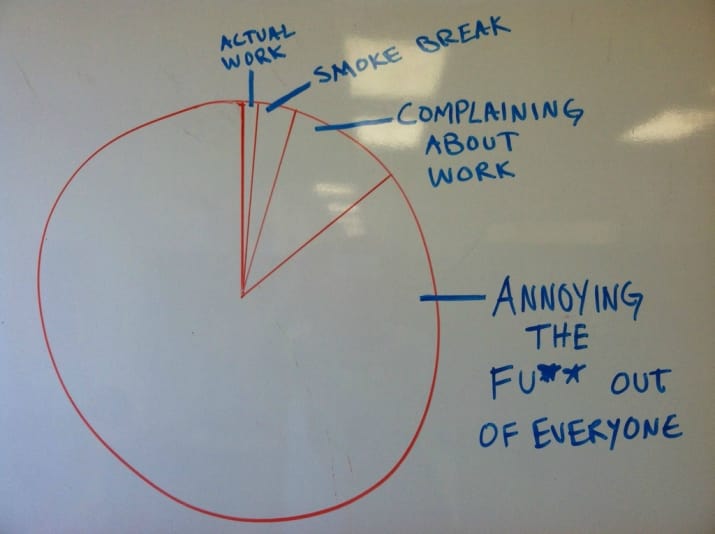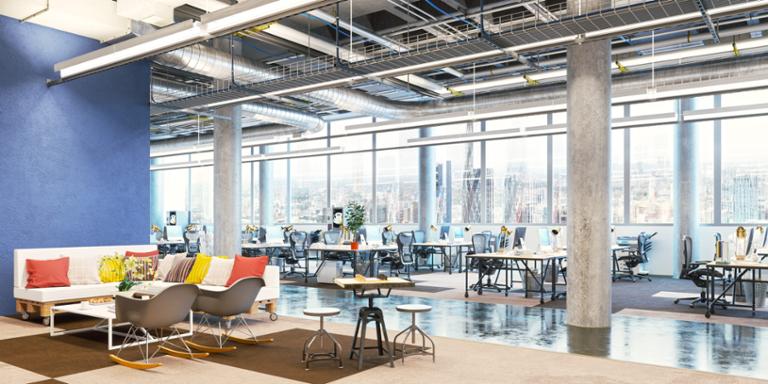 A place to ‘get away’ is also necessary. It could be meeting rooms for teams, or private bungalows meant for phone calls, or both. Whatever the case, any open office should have these rooms, and you should take advantage of them whenever it’s feasible. Don’t be a room-squatter, but do feel free to slip into a more private space when you need to focus. Open offices are stressful because they’re over-stimulating. Part of that comes with too much human interaction. You can’t always dip into a private room or sneak away to a less-visited common area, so you’ll have to devise a way to sidestep people who want to approach you for no reason. This is why headphones are popular. Headphones may work great for you. Letting people know you’re not available for a chat is also a good strategy. This could be a sign on your desk, or some other visual cue that lets them know you’re deep in some codebase or trying to get to ‘inbox zero.’ Whatever you choose, find a way to let people know you’re tuned into work and not the random chatter around the office. We also advocate for a standing desk of some sort. It could be a proper standup desk, or an add-on that lets you place a laptop on a pedestal. Either way, doing something other than sitting for hours on end is a good option; a study shows the standing desk can improve your mental faculties. Open offices won’t go away. They’re a cheap alternative to building a proper workspace, and companies are convinced their staff like (or at least accept) them. Courtesy goes a long way, so don’t be afraid to insist on quiet hours or the ability to schedule some time in the private bungalows to help you and (everyone else) focus.
A place to ‘get away’ is also necessary. It could be meeting rooms for teams, or private bungalows meant for phone calls, or both. Whatever the case, any open office should have these rooms, and you should take advantage of them whenever it’s feasible. Don’t be a room-squatter, but do feel free to slip into a more private space when you need to focus. Open offices are stressful because they’re over-stimulating. Part of that comes with too much human interaction. You can’t always dip into a private room or sneak away to a less-visited common area, so you’ll have to devise a way to sidestep people who want to approach you for no reason. This is why headphones are popular. Headphones may work great for you. Letting people know you’re not available for a chat is also a good strategy. This could be a sign on your desk, or some other visual cue that lets them know you’re deep in some codebase or trying to get to ‘inbox zero.’ Whatever you choose, find a way to let people know you’re tuned into work and not the random chatter around the office. We also advocate for a standing desk of some sort. It could be a proper standup desk, or an add-on that lets you place a laptop on a pedestal. Either way, doing something other than sitting for hours on end is a good option; a study shows the standing desk can improve your mental faculties. Open offices won’t go away. They’re a cheap alternative to building a proper workspace, and companies are convinced their staff like (or at least accept) them. Courtesy goes a long way, so don’t be afraid to insist on quiet hours or the ability to schedule some time in the private bungalows to help you and (everyone else) focus. Open Office Floor Plan: How to Survive and Thrive
Most tech pros have a distaste for open office floor plans. We can’t blame them. The open office plan is typically panned, and there’s strong proof it can be counter-productive to productivity. Despite that, companies will still build them, so here’s how to make the best of it. First, consider why a company has an open office plan: cost. It’s much easier to slam desks into a space and ask teams to get to work than it is to build actual, private rooms (or even cubicles) for everyone. This design is also more modular, and lends itself to company growth. It’s far simpler to find desk space for 20 developers than build 20 new unique office areas. Jason Fried, founder and CEO at Basecamp, is a fan of the open office idea. In a Medium post, he lays out all the bells and whistles that Basecamp's open office offers, the better to help people stay productive. One unique policy is ‘library rules.’ By Fried’s estimation, the expectation of silence in a library helps people focus. At Basecamp, people are expected to treat the open space like a library and speak in hushed tones. It’s a clever rule, and one any company with an open office should consider. While we don’t advocate that every company adopt the actual ‘library rules’ policy of Basecamp, yours could have some guidelines on staying respectfully quiet in the open space. If it doesn’t, ask your HR department to institute them.  A place to ‘get away’ is also necessary. It could be meeting rooms for teams, or private bungalows meant for phone calls, or both. Whatever the case, any open office should have these rooms, and you should take advantage of them whenever it’s feasible. Don’t be a room-squatter, but do feel free to slip into a more private space when you need to focus. Open offices are stressful because they’re over-stimulating. Part of that comes with too much human interaction. You can’t always dip into a private room or sneak away to a less-visited common area, so you’ll have to devise a way to sidestep people who want to approach you for no reason. This is why headphones are popular. Headphones may work great for you. Letting people know you’re not available for a chat is also a good strategy. This could be a sign on your desk, or some other visual cue that lets them know you’re deep in some codebase or trying to get to ‘inbox zero.’ Whatever you choose, find a way to let people know you’re tuned into work and not the random chatter around the office. We also advocate for a standing desk of some sort. It could be a proper standup desk, or an add-on that lets you place a laptop on a pedestal. Either way, doing something other than sitting for hours on end is a good option; a study shows the standing desk can improve your mental faculties. Open offices won’t go away. They’re a cheap alternative to building a proper workspace, and companies are convinced their staff like (or at least accept) them. Courtesy goes a long way, so don’t be afraid to insist on quiet hours or the ability to schedule some time in the private bungalows to help you and (everyone else) focus.
A place to ‘get away’ is also necessary. It could be meeting rooms for teams, or private bungalows meant for phone calls, or both. Whatever the case, any open office should have these rooms, and you should take advantage of them whenever it’s feasible. Don’t be a room-squatter, but do feel free to slip into a more private space when you need to focus. Open offices are stressful because they’re over-stimulating. Part of that comes with too much human interaction. You can’t always dip into a private room or sneak away to a less-visited common area, so you’ll have to devise a way to sidestep people who want to approach you for no reason. This is why headphones are popular. Headphones may work great for you. Letting people know you’re not available for a chat is also a good strategy. This could be a sign on your desk, or some other visual cue that lets them know you’re deep in some codebase or trying to get to ‘inbox zero.’ Whatever you choose, find a way to let people know you’re tuned into work and not the random chatter around the office. We also advocate for a standing desk of some sort. It could be a proper standup desk, or an add-on that lets you place a laptop on a pedestal. Either way, doing something other than sitting for hours on end is a good option; a study shows the standing desk can improve your mental faculties. Open offices won’t go away. They’re a cheap alternative to building a proper workspace, and companies are convinced their staff like (or at least accept) them. Courtesy goes a long way, so don’t be afraid to insist on quiet hours or the ability to schedule some time in the private bungalows to help you and (everyone else) focus.
 A place to ‘get away’ is also necessary. It could be meeting rooms for teams, or private bungalows meant for phone calls, or both. Whatever the case, any open office should have these rooms, and you should take advantage of them whenever it’s feasible. Don’t be a room-squatter, but do feel free to slip into a more private space when you need to focus. Open offices are stressful because they’re over-stimulating. Part of that comes with too much human interaction. You can’t always dip into a private room or sneak away to a less-visited common area, so you’ll have to devise a way to sidestep people who want to approach you for no reason. This is why headphones are popular. Headphones may work great for you. Letting people know you’re not available for a chat is also a good strategy. This could be a sign on your desk, or some other visual cue that lets them know you’re deep in some codebase or trying to get to ‘inbox zero.’ Whatever you choose, find a way to let people know you’re tuned into work and not the random chatter around the office. We also advocate for a standing desk of some sort. It could be a proper standup desk, or an add-on that lets you place a laptop on a pedestal. Either way, doing something other than sitting for hours on end is a good option; a study shows the standing desk can improve your mental faculties. Open offices won’t go away. They’re a cheap alternative to building a proper workspace, and companies are convinced their staff like (or at least accept) them. Courtesy goes a long way, so don’t be afraid to insist on quiet hours or the ability to schedule some time in the private bungalows to help you and (everyone else) focus.
A place to ‘get away’ is also necessary. It could be meeting rooms for teams, or private bungalows meant for phone calls, or both. Whatever the case, any open office should have these rooms, and you should take advantage of them whenever it’s feasible. Don’t be a room-squatter, but do feel free to slip into a more private space when you need to focus. Open offices are stressful because they’re over-stimulating. Part of that comes with too much human interaction. You can’t always dip into a private room or sneak away to a less-visited common area, so you’ll have to devise a way to sidestep people who want to approach you for no reason. This is why headphones are popular. Headphones may work great for you. Letting people know you’re not available for a chat is also a good strategy. This could be a sign on your desk, or some other visual cue that lets them know you’re deep in some codebase or trying to get to ‘inbox zero.’ Whatever you choose, find a way to let people know you’re tuned into work and not the random chatter around the office. We also advocate for a standing desk of some sort. It could be a proper standup desk, or an add-on that lets you place a laptop on a pedestal. Either way, doing something other than sitting for hours on end is a good option; a study shows the standing desk can improve your mental faculties. Open offices won’t go away. They’re a cheap alternative to building a proper workspace, and companies are convinced their staff like (or at least accept) them. Courtesy goes a long way, so don’t be afraid to insist on quiet hours or the ability to schedule some time in the private bungalows to help you and (everyone else) focus. 

